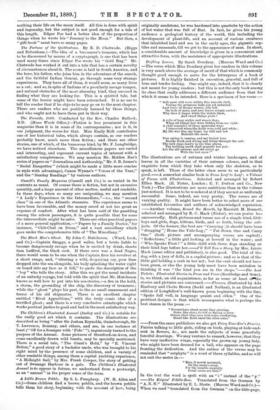Drifting Leaves. By Sarah Doudney. (Marcus Ward and Co.) —The
verse which Miss Doudney gives her readers in this volume• is very much above the average of merit of that which is commonly thought good enough to serve for the letterpress of a book of pictures. It is highly finished in execution, graceful, and full of true and tender feeling. One might say, indeed, that it is clearly not meant for young readers ; but this is not the only book among its class that really addresses a different audience from that for which it seems to be intended. Here is a specimen of her verse :— " Soft snow still rests within this wayside cleft, Veiling the primrose buds not yet unfurled: Lost trace of dreary winter, idly left On beds of moss, and sere leaves crisply curled ; Why does it linger while the violets blow, And sweet things grow?
A relic of long nights and weary days, When all things fair were hidden from my eight: A chill reminder of those mournful ways I traversed when the fields were cold and white ; My life was dim, my hopes Icy still and low Beneath the snow.
Now spring is coming, and my buried love Breaks fresh and strong and living through the sod ; The lark sings loudly in the blue above, The budding earth shall magnify her god : Let the old sorrows and old errors go With the lost snow!"
The illustrations are of autumn and winter landscapes, and of leaves in all the varieties of their autumn colours, and in that exquisite form which they take when only the skeleton, so to speak, is left. Those of the latter class seem to us particularly good. —A somewhat similar book is From Leaf to Leaf : a Volume of Poems with Illustrations. Selected and arranged by Robert Ellice Mack. (E. Nister, London ; E. P. Dutton and Co., New York.)—The illustrations are more ambitious than in the volume just noticed. It is not to be wondered at if they are not so uniformly successful. Some, indeed, are very pretty. The verses are of varying quality. It might have been better to select more of our established favourites and authors of acknowledged reputation. —Another volume, Round the Hearth, by Harriett M. Bennett, selected and arranged by R. C. Mack (Nister), we can praise less unreservedly. Both pictures and verses are of a simple kind, little boys and girls, dogs, kittens, birds, and so forth, being the sub- jects. Of the former, the best are "Carrying [it should have been " dragging "] Home the Yule-Log;" "Put Down One and Carry One" (both picture and accompanying verses are capital) ; "Reflections," a little girl looking at herself in the water ; and "Who Speaks First ? " a little child with three dogs standing on their hind legs before her.—ru Tell You a Story, by Mrs. Lizzie Mack (same editor and publisher), is also good. The trial of the dog, with a jury of dolls, is a capital picture ; and so is that of the little girl holding a crab in her net; but the crab should not have been green, or else the young lady must have been mistaken in thinking it was "the kind you see in the shops."—The Lost Tickets : Illustrated Stories in Prose and Verse (Routledge and Sons), is, we think, an old acquaintance, as far as some at least ofothe stories and pictures are concerned. —Flowers, illustrated by Ada Hanbury and elate Brown (Sockl and Nathan), is an illustrated edition of Longfellow's well-known poem beginning with the line, " Spake full well, in language quaint and olden." One of the prettiest designs is that which accompanies what is perhaps the best stanza in the poem :— " Everywhere about us are they glowing, Some like stars, to tell us Spring is born : Others their blue eyes with tears Werflowing, Stand like Ruth amid the alien corn."
From the same publishers we also get Fairy Fine-Ear's Fancies. Fairies talking to little girls, riding on birds, playing at hide-and- seek in flowers, &c., are made the subjects of some gracefully fanciful drawings. We may venture to remark, however, that they have very ineffective wings, especially the grown-up young lady, who might have been dressed for a ball, who appears on the page fronting the dedication. And the author of the verses may be reminded that " zoophyte " is a word of three syllables, and so will not suit the metre in :— " Rise, 0 merry mermaid, On the ocean's crest, For the humble zoophyte Coral caves are best."
In the text the word is spelt with an " i " instead of the "y." —The Kelpies' .Fiddle-Bow. Translated from the German by " A. N. N." Dlustrated by E. L. Shute. (Marcus Ward and Co.)— When we read "translated from the German" on the title-page,
we do not expect to be told that the hero learns to play "Kale Britannia." "Adapted" should rather have been the word. As it is, we have a story that is neither German nor English. But the pictures are decidedly good, and the tale will be found enter- taining.—From the same publishers we have also received Where Lilies Live, and Waters Wind Away. Pictures by Edith S. Berkeley. Verses by F. W. Bourdillon.—The pictures are sometimes very good, though we think that now and then the colouring might have been more harmoniously contrived. One of the prettiest of the whole series, to our fancy, is that of "Maud and Marjorie," for which colour has not been used. Of the coloured illustrations, "The Rats on the Water-Lily Leaves" are as good as any. The verses are bright and merry, with a tuneful jingle in them.











































 Previous page
Previous page